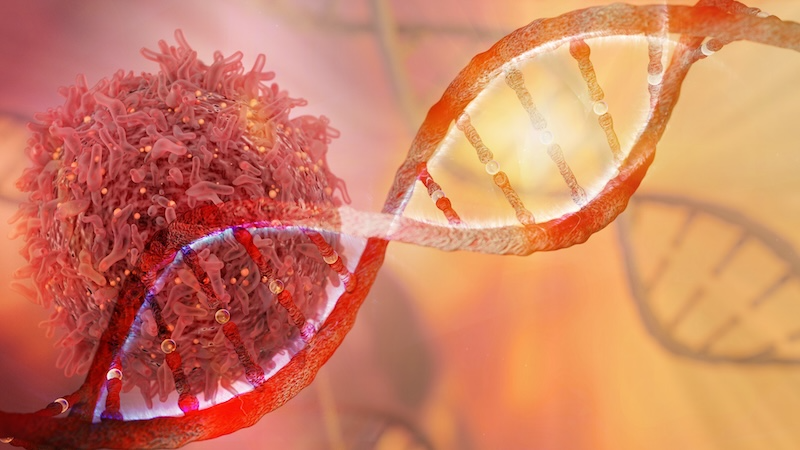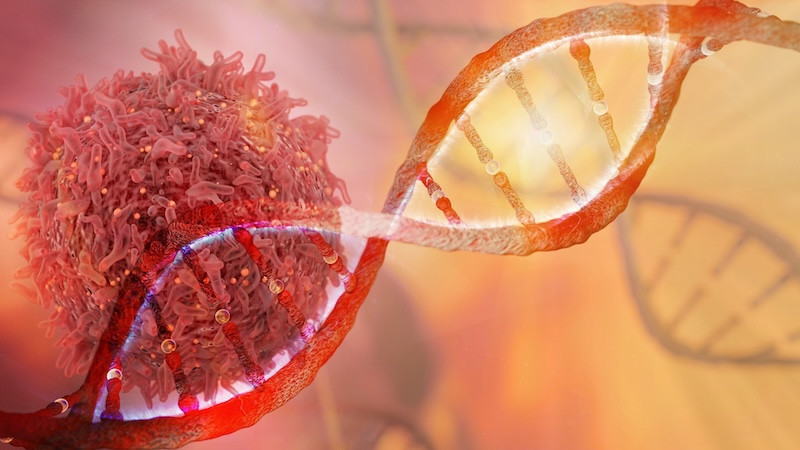Noninvasive Alternative to Cancer Biopsy
The path toward a cancer diagnosis is anything but fun. Among the least enjoyable aspects of the journey are the invasive and often excruciating biopsies that are needed to collect information about the genetic mutations or chromosomal abnormalities of the cells in a growing tumor. This information is critical for an accurate diagnosis of a patient’s cancer, as well as for prognosis predictions and treatment selections. At the recent Acoustical Society of America meeting in Ottawa, Canada, Roger Zemp of the University of Alberta reported on an alternative method that he and his colleagues have developed for extracting this genetic information that uses sound waves rather than tissue removal. “Traditional biopsies with their big needles are scary and painful,” says Joy Wang, a master’s student who works with Zemp. “Our method is pain free and can provide clearer information about a cancer’s genetics.”
Biopsy needles are akin to hole punches for the flesh. These long, hollow needles can be over 2 mm in diameter and typically punch out a core of flesh between 1 and 2 mm in diameter. For comparison, the average blood-draw needle is half a millimeter in diameter. The large holes made by the biopsy needles significantly increase the likelihood of pain, swelling, bruising, or infection at the biopsy site, both during the biopsy collection and for days afterward.
The prospect of being left black and blue can cause patients significant anxiety. The worry can become so high that it can stop a person from getting a questionable lump or bump checked out. Therefore, researchers have been searching for less invasive, less frightening methods to retrieve the information that biopsies provide. Alternative techniques could also allow for earlier detection of some cancers, Zemp says.
The techniques developed by Zemp and his team use ultrasound pulses to stimulate cancer cells to release the genetic information they house. This information then circulates in the bloodstream and so can be extracted from a patient during a routine blood draw, which is less painful for the patient as well as significantly cheaper and easier to perform than a traditional biopsy.
In one set of tests, Zemp and his colleagues used a highly focused low-frequency ultrasound beam with an intensity about 10 times greater than that of the higher-frequency ultrasound waves used during medical imaging. The ultrasound beam, which is essentially a wave of alternating cycles of compressing peaks (high pressure) and decompressing troughs (low pressure), interacted with dissolved gases inside the tumor cells. The low-pressure part of the wave induced the gas molecules within the cells to coalesce into bubbles. The high-pressure part then caused the bubbles to implode. The force produced during this implosion was sufficient to temporarily open small holes, or passageways, through the membranes of cells in the path of the beam tissue. For some tests, the team used an ultrasound beam with an intensity 100 times that used in medical imaging. For those tests, the ultrasound beam permanently broke apart the tumor cells, causing the cells to release all their contents, which could be helpful in certain situations.
For mice growing cancerous human tumors, the team found that, in both sets of tests, the biomolecules released by the cells increased the concentration of cancer-relevant DNA and RNA biomarkers in the bloodstream by up to a factor of 100. That increase was sufficient for detection of the biomarkers with a blood test. The team also tested the efficacy of the technique by extracting material directly from the mice tumors with a 0.5-mm-diameter fine needle. For those samples the biomarker concentration increased by up to 50,000 times, Wang says. “People have been looking for ways to use blood tests to make diagnoses for quite some time, but it’s challenging because very few tumor-specific biomarkers are naturally present in the blood,” Zemp says. “Our enhancements could make this process much easier.”
Zemp and his colleagues have also shown that their technique could allow early detection of cancer biomarkers via a blood test. Tumor cells circulate in the blood of most cancer patients, even those without metastatic cancer. But at one or two cells per milliliter of blood, finding one in a blood test is “a billion-to-one kind of a needle-in-a-haystack problem,” Zemp says. It can be done, but at a price tag of over $10,000 per test, it’s not a routine assessment method. Applying their ultrasound technique to blood samples taken from patients with prostate cancer, Zemp and his colleagues have shown that they were able to burst apart cancer cells present in the blood and detect their contents. In a clinical setting, such a test could cost just a few tens of dollars, Zemp says.
The team is working on demonstrating the early-detection method for a larger number of clinical samples. They are also working on developing a technique that could allow them to use ultrasound waves to probe bone tissue. Unlike the soft tissues and blood samples the team has mostly worked with, bone cells are highly reflective of ultrasound waves, making it hard to break them apart. Being able to penetrate the bone with ultrasound pulses would allow clinicians to reach the bone’s soft core, its marrow, the sampling of which is often required for diagnoses and staging of cancers such as leukemia, lymphoma, or myeloma. Zemp’s team is developing an ultrasound “drill” that could allow release of leukemia cells with significantly less damage to the bone than a traditional biopsy.
While needle-free alternatives to bone-marrow biopsies are still speculative, those for soft-tissue tumors are nearing in vivo human trials. For Wang, being able to add such a technique to the arsenal clinicians use in cancer diagnoses could be a game changer, allowing them to more quickly, easily, and cheaply obtain patient-specific information. “Every single patient’s cancer is completely different,” Wang says. “If we want to improve outcomes for cancer patients, we really need treatment plans that are tailored to the specific properties of their cancer. If we can do that, curing cancer could be much easier.”
–Katherine Wright
Katherine Wright is the Deputy Editor of Physics Magazine.





